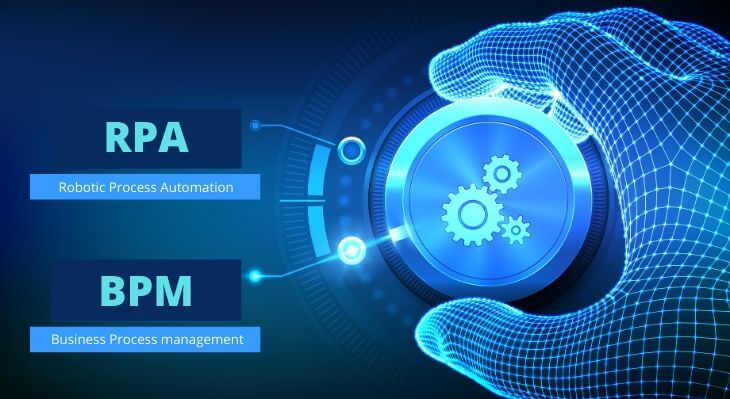In the 4.0 era of technology, robots are considered as one of the greatest inventions of humanity. It is widely applied in life in many different fields. One of the types of technology robots that are commonly used by businesses today is RPA and BPM.
These are two software robots that help solve problems related to process automation. Why are they separated into 2 different types, and when BPM and RPA combined, is there any effect? All questions will be answered in the article below.
What is RPA?
RPA’s full English name is Robotic Process Automation. This is a software robot that automates the process. Specifically, RPA specializes in handling repetitive tasks with fixed logic. Since the robot cannot learn on its own, it works thanks to pre-installed human settings.
Therefore, after setting up the process, the automation robot will remember and repeat the next time.
Currently, we can divide Robotic Process Automation into 2 different types: Attended RPA and Unattended RPA. While Attended RPA works on a certain server, Unattended RPA can operate on a large server without human intervention.
The advantage of RPA is that it can quickly solve office tasks such as data entry and data processing on the office platform. Specifically, the working time of the robot is only half that of a human. Not only that, the accuracy of RPA is approximately 100%, and there are very few errors. Automated robots also have flexible working hours, and they can work 24 hours continuously without human supervision.
With the superior features of Robotic Process Automation, businesses are gradually shifting from manual labor to automated labor. RPA slowly appears more in certain jobs that can automate the process. They are widely applied in many fields such as insurance, sales, banking.
Read more: What is RPA?
What is BPM?
BPM, whose full name is Business Process Management, is a business process management solution for businesses. BPM software allows companies to model, deploy, execute, monitor, and optimize processes.
BPM’s mission is to help provide businesses based on a business process or set of business processes. In the implementation process, the business management software will optimize the process by offering solutions to overcome difficulties in work.
The steps taken by BPM in business are:
- Design: Break the process down into multiple tasks
- Model: Model it using suitable BPM software
- Execute: Execute the process or put a system in place
- Monitor: Monitor and analyze the system
- Optimize: Make changes to the process to improve it
Business Process Management systems are distinguished based on their intended use:
- Integration – Centric BPM is a business process management system with no human involvement. They specialize in handling processes between systems: HRMS, CRM, and ERP. Management systems focus on integration, with extensive API access and connectors to enable rapid workflow creation.
- Human-Centric BPM is human-centered business process management software. They are performed mainly by humans, assisting the individual in completing the task. The platform has a user-friendly interface, easy notifications, and fast-tracking.
- Document – Centric BPM: this is the solution applied to the document processing process (contracts, agreements,…). A platform for technology enables users to route, define, and receive signed documents as tasks move through the business process.

The Benefits of Combining RPA and BPM
Boosts Employee Productivity
RPA allows users to automate time-consuming, repetitive tasks. Employees will not have to do boring jobs. They can move to positions that need more creativity and fun. When you combine RPA and BPM in business processes, the work will be more optimized, increasing work productivity.
Decisions in Approval Processes
In the approval process, you can combine RPA and BPM to make work more efficient. The automation robot will do some minor work during the approval process.
BPM will automate and optimize the approval process. At the same time, the management software ensures compliance with regulations to create a fast and efficient approval process.
Automating processes from start to end
End-to-end process work involves combining multiple parts with different systems. In addition, in the processes, there will be rules and notes such as manual operation is required when the data quality is low,… With the use of RPA with BPM in the process, you can optimize the working process. BPM will provide the right solutions for the process to be carried out continuously.
Handling Exceptions
When Robotic Process Automation encounters an exception that renders it inoperable and requires human intervention through exception management, BPM will streamline this process by clearly defining exceptions to handle and monitor.
From there, RPA and BPM help improve work efficiency, ensuring the process is done right.
Power to automate complex workflows
The advantage of RPA is that it can handle desk jobs quickly and accurately. But for complex jobs, automated robots will not be able to work. When RPA combined with BPM, the work becomes easier.
For example, the feature of creating user interfaces, transferring tasks between departments, or managing access rights. All these features are available in BPM that RPA does not have. We can combine the two to be able to solve the most effective work.
Conclusion
We cannot deny the great benefits of combining Robotic Process Automation and Business Process Management. One side is a process automation robot, the other is process management software. When we integrate the system including the two technologies above, it will help the work be solved quickly and conveniently.
WinActor is a process automation robot developed based on RPA software. This is a technology product developed by NTT Group, specializing in providing intelligent solutions to serve the needs of users. In addition, NTT Group has a team of experienced staff, ready to answer any questions from customers.
If you are wondering about a reputable address providing technology solutions such as RPA, then WinActor of NTT Group may be the perfect choice for you.

WinActor is an RPA software solution by NTT DATA Corporation to help businesses master technology, create breakthroughs in the digital age 4.0.




